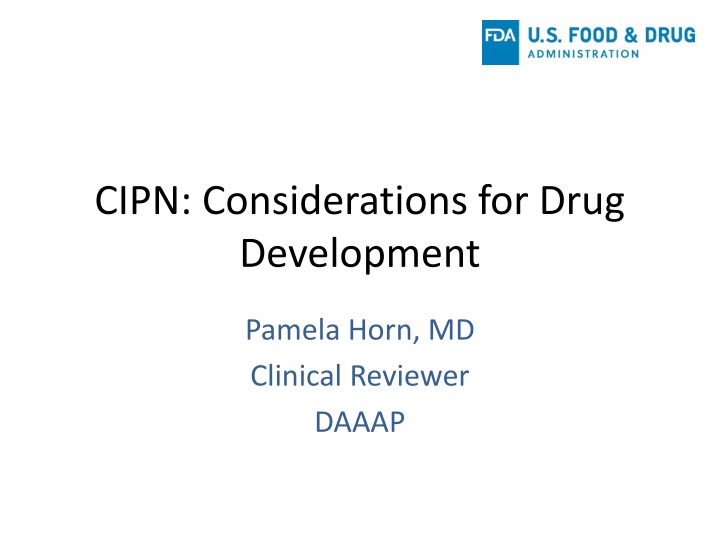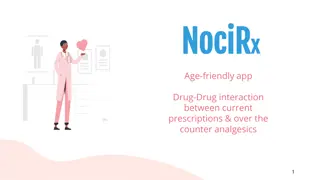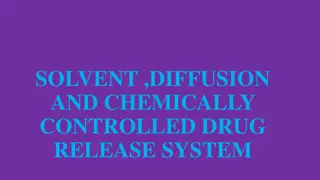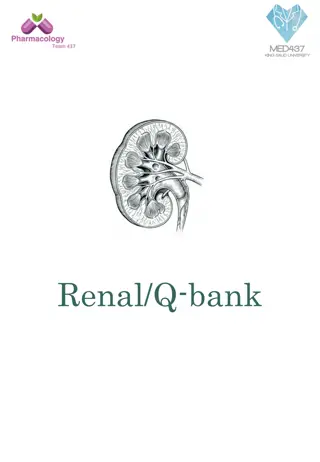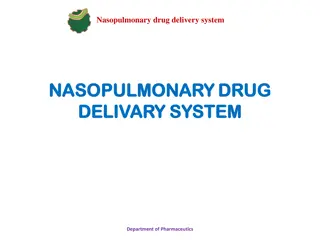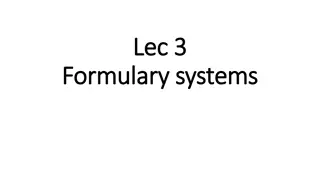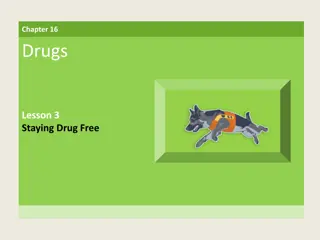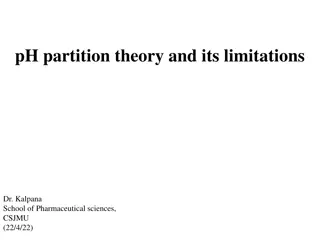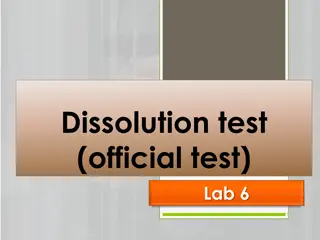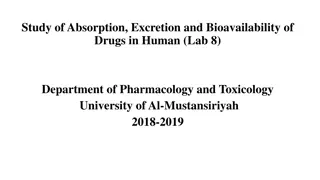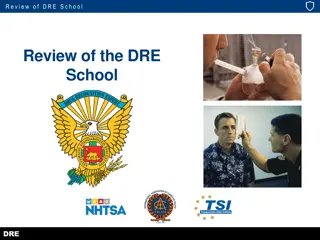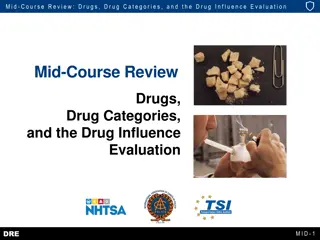Considerations for Drug Development in CIPN
Patient perspectives and treatment discussions in drug development for Chemotherapy-Induced Peripheral Neuropathy (CIPN). Insights from FDA meetings, symptoms, impacts, approved therapies, and drug approval standards highlighted. Treatment options, effectiveness, safety considerations, and the need for improved management discussed.
Download Presentation

Please find below an Image/Link to download the presentation.
The content on the website is provided AS IS for your information and personal use only. It may not be sold, licensed, or shared on other websites without obtaining consent from the author.If you encounter any issues during the download, it is possible that the publisher has removed the file from their server.
You are allowed to download the files provided on this website for personal or commercial use, subject to the condition that they are used lawfully. All files are the property of their respective owners.
The content on the website is provided AS IS for your information and personal use only. It may not be sold, licensed, or shared on other websites without obtaining consent from the author.
E N D
Presentation Transcript
CIPN: Considerations for Drug Development Pamela Horn, MD Clinical Reviewer DAAAP
Outline Patient Perspective from PFDD Public Meeting Drug Approval Standards Approved Therapies Possible CIPN Indications FDA Review Division Roles Study Design Issues Raised by Sponsors Population Dose and Dosing Concomitant and Rescue Medication Use Outcome Measures Endpoints Safety Assessment 2
Patient-Focused Drug Development Meeting on Peripheral Neuropathy FDA held a public meeting attended by patients caregivers and advocates on June 10, 2016 37 patients attended in-person and 54 participants contributed through live webcast CIPN well-represented Summary report posted February 2017 at https://www.fda.gov/downloads/ForIndustry/U serFees/PrescriptionDrugUserFee/UCM542169. pdf 3
Summary of Patient Symptoms and Impact Pain sensations most commonly described as numbness, tingling, burning, and stabbing particularly in hands and feet In addition to painful sensations, numbness identified as having high impact due to functional consequences (e.g. loss of balance and falls) Participants described impact as daily on activities, work, and relationships Not well-managed currently for nearly all 4
Summary of Treatment Discussion Pregabalin and gabapentin, wide range of effectiveness reported, adverse reactions noted frequently were dizziness, somnolence, dry mouth, edema, blurred vision, weight gain, difficulty with concentration/attention NSAIDS, opioids, drugs by epidural and topical ROA also reported Massage, PT, acupuncture, vitamin supplements Diet, exercise 5
Drug Approval Standards Approval requires: Substantial evidence of efficacy Two adequate and well-controlled trials or equivalent for a specific peripheral neuropathic pain indication Three successful trials in three separate neuropathic pain conditions for a general peripheral neuropathic pain indication Adequate assessment of safety in a sufficient number of individuals for an adequate duration of exposure Favorable risk-benefit balance 6
Approved Drugs for Peripheral Neuropathic Pain Diabetic Peripheral Neuropathy (DPN): Nucynta ER (Tapentadol) Lyrica (Pregabalin) Cymbalta (Duloxetine) Postherpetic Neuralgia (PHN): Lyrica (Pregabalin) Neurontin (Gabapentin) Transdermal lidocaine Capsaicin 8% patch Trigeminal Neuralgia: Tegretol (Carbamazepine) 7
Division roles DAAAP reviews and provides advice pertaining to development of drugs for the treatment of pain and peripheral neuropathies, including CIPN DAAAP consults DOP1 to gain input on clinical considerations in studying oncology patients and managing possible impact of interventions on cancer treatment COA regarding validity and testing of PRO instruments 8
Possible CIPN Indications Prevention Treatment Chemotherapy CIPN: pain, other symptoms or signs Symptoms appear with first dose Symptoms appear after last dose 9
Population Number of different chemotherapy agents to include in one study Single agent Single class (taxane, platinum) Multiple classes Entry criteria for prevention Cancer diagnosis (e.g. colon cancer), and life expectancy (e.g. 12 weeks) Planned chemotherapy regimen(s) Entry criteria for treatment Baseline pain (avg NRS 5-9, > 4) NCI CTCAE (e.g. > Grade I) Clinical diagnosis of CIPN based on symptoms and neurological signs Completed or concurrent chemotherapy regimen 10
Dose and Dosing Dose selection Dose same as dosing for chemotherapy treatment Dose selection based on Phase 2 work in a pain or neuropathy endpoint Placebo control Double-blind Fixed dosing interval Fixed and flexible dosing Patient-administered and clinician-administered 11
Concomitant and Rescue Medication Use Allow standardized concurrent use of stable dose of analgesics Allow limited rescue medications 12
Outcome Measures Pain only (11-point NPRS/ BPI-SF) PRO with composite/ multiple manifestations of disease in one instrument (EORTC QLQ-CIPN20, FACT/GOG-Ntx-4) Novel PRO Clinician-reported (Sanofi-NCI) 13
11-point NPRS Source: http://www.physio-pedia.com/Numeric_Pain_Rating_Scale http://www.wikidoc.org/index.php/Pain_physical_examination 14
BPI SF 15
FACT/GOG-Ntx-4 Source: www.facit.org/LiteratureRetrieve.aspx?ID=42412 16
Sanofi-NCI Source: Eloxatin Prescribing Information 17
Summary CIPN not adequately managed with available therapies for many patients; efficacious prevention and treatment options are needed Range of proposals have been made CIPN is a distinct peripheral neuropathy and there are study design issues unique to CIPN 18
